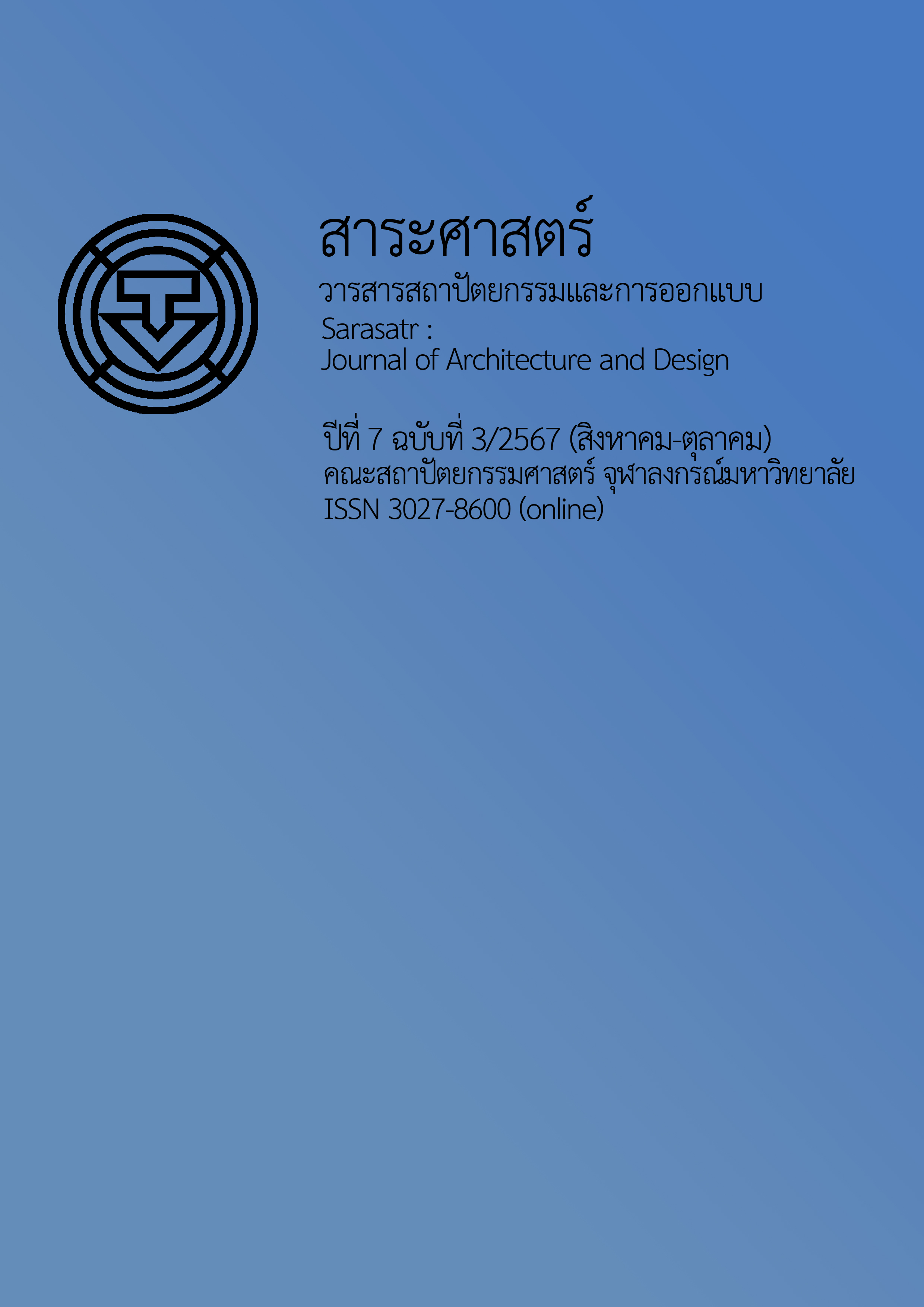Guidelines for Material Selection in Building Components to Reduce Life Cycle Impacts in Office Buildings in Thailand
Main Article Content
Abstract
Nowadays, the primary cause of the greenhouse effect in the building sector is energy use during the operational phase. However, construction material manufacturing is another significant contributor to greenhouse gas emissions. For this reason, choosing environmentally friendly construction materials is crucial and should be considered at the building design stage to reduce environmental impacts as much as possible.
This research focuses on assessing the environmental impact of office buildings in Thailand through two case studies, each with a gross floor area not exceeding 10,000 square meters and different building materials, using the life cycle assessment method according to the EN-15978 (2011) standard. Data on material quantities were collected from building information modeling (BIM) and construction documents. The impacts were evaluated using One Click LCA, and the energy use was analyzed using EnergyPlus. Findings indicate that flooring systems emit the most greenhouse gases, followed by piles and exterior wall systems. Four mitigation strategies aligned with these high-impact components are proposed, including 1) Replacing post-tensioned slabs with bubble deck slabs, 2) Increasing the use of fly ash in concrete, 3) Replacing external walls with autoclaved aerated concrete block walls, and 4) Replacing external wall with fiber cement walls (Case Study 1 switch from a precast concrete wall system, and Case Study 2 switch from a Masonry wall system). Each strategy could reduce energy use and environmental impact compared to the reference building design, aligning with LEED BD+C V4.1 criteria.
Article Details
References
กันตพงศ์ ศรีเมือง, อรรจน์ เศรษฐบุตร, และสริน พินิจ. (2565). การประเมินผลมาตรการประหยัดพลังงานและการลดการปล่อยก๊าซเรือนกระจกในอาคารสำนักงานและคอนโดมิเนียมพักอาศัย ด้วยการประเมินต้นทุนส่วนเพิ่มสุทธิของการลดการปล่อยคาร์บอน. สาระศาสตร์, 5(3), 509-522.
ชนิกานต์ ยิ้มประยูร, รัตนาวรรณ มั่งคั่ง, ภัทรนันท์ ทักขนนท์, และสิงห์ อินทรชูโต. (2564). เกณฑ์ประเมินและให้ฉลากแบบบ้านประหยัดพลังงานและเป็นมิตรกับสิ่งแวดล้อมโดยอิงการจำลองพลังงานและการประเมินวัฏจักรชีวิต. วารสารวิจัยและสาระสถาปัตยกรรม/การผังเมือง, 19(1), 179-200. https://doi.org/10.56261/jars.v19i1.243880
ภาคภูมิ วานิช. (2561, 28 เมษายน). ระบบพื้นไร้คานท้องเรียบแบบกลวง. SNP-POST. https://snp-precast.snp post.com/knowledge-read/14
อรรจน์ เศรษฐบุตร. (2555). ดัชนีปลดปล่อยคาร์บอนไดอ๊อกไชค์ของอาคารในประเทศไทย. วารสารสถาปัตยกรรม, 61, 147-162.
American Society of Heating, Refrigerating and Air-Conditioning Engineers. (2016). ASHRAE standard 90.1-2016: Energy standard for buildings except low-rise residential buildings. ASHRAE.
Babalu, R., Anil, A., Sudarshan, K., & Amol, P. (2023). Compressive strength, flexural strength, and durability of high-volume fly ash concrete. Innovative Infrastructure Solutions, 8, 154. https://doi.org/10.1007/s41062-023-01120-x
Ecoinvent. (n.d.). ecoinvent database. https://ecoinvent.org/database/
EnergyPlus. (n.d.). EnergyPlus. https://energyplus.net/
European Committee for Standardization. (2012). CEN EN 15978:2011 Sustainability of construction works - Assessment of environmental performance of buildings - Calculation method. https://standards.iteh.ai/catalog/standards/cen/62c22cef-5666-4719-91f9-c21cb6aa0ab3/en-15978-2011
Fouad, F., Ramadan, W., Schoch, T., & Kirby, J. (2023). Environmental performance of autoclaved aerated concrete in the USA. ICAAC 2023: 7th International Conference on Autoclaved Aerated Concrete, 6(2), 5-14. https://doi.org/10.1002/cepa.2223
Gibbon, O., Orr, J., Archer-Jones, C., Arnold, W., & Green, D. (2022). How to calculate embodied carbon (2nd ed.). The Institution of Structural Engineers. https://www.egbc.ca/getmedia/a7603519-43cc-4795-8558-6960b2b7b5d1/HTCEC-2nd-edition.pdf.aspx
Hammond, G. P., & Jones, C. I. (2008). Embodied energy and carbon in construction materials. Proceedings of the Institution of Civil Engineers – Energy, 161(2), 87-98. https://doi.org/10.1680/ener.2008.161.2.87
International Organization for Standardization. (2006). ISO 14040: 2006(en) Environmental management Life cycle assessment principles and framework. https://www.iso.org/standard/37456.html
Kofoworola, O., & Gheewala, S. (2008). Environmental life cycle assessment of a commercial office building in Thailand. International Journal of Life Cycle Assessment, 13, 498-511. https://doi.org/10.1007/s11367-008-0012-1
Lawrie, L., & Crawley, D. (2022). Development of global typical meteorological years (TMYx). http://climate.onebuilding.org
Layton, M. (2023, December 26). How long does fiber cement siding last? Today’s Homeowner. https://todayshomeowner.com/siding/guides/how-long-does-fiber-cement-siding-last/
Oukaili, N., & Merie, H. (2019). Sustainability analysis and shear capacity of bubble deck slabs with openings. In Proceedings in 2018 11th International Conference on Developments in eSystems Engineering (DeSE) (pp. 250-255). IEEE. https://doi.org/10.1109/DeSE.2018.00051
Overbey, D. (2021, January 29). LCA stages matter when tracking embodied carbon. Building Enclosure Online. https://www.buildingenclosureonline.com/blogs/14-the-be-blog/post/89547-lca-stages-matter-when-tracking-embodied-carbon
Sphera. (n.d.). Product sustainability gabi data search. https://sphera.com/product-sustainability-gabi-data-search/
Thomas, M. D. A. (2007). Optimizing the use of fly ash in concrete (Vol. 5420). Portland Cement Association.
United Nations Environment Programme. (2022). 2022 Global status report for buildings and construction: Towards a zero-emission, efficient and resilient buildings, and construction sector. https://www.unep.org/resources/publication/2022-global-status-report-buildings-and-construction
U.S. Green Building Council. (2019). LEED v4.1. https://www.usgbc.org/leed/v41
World Health Organization [WHO]. (2023, October 12). Climate change. https://www.who.int/news-room/fact-sheets/detail/climate-change-and-health
Zijlstra, S. (n.d.). Impact assessment categories: CML, TRACI, and PEF. One Click LCA. https://oneclicklca. zendesk.com/hc/en-us/articles/360015036980-Impact-Assessment-Categories-CML-TRACI-and-PEF


